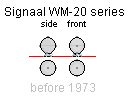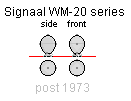Signaal M20 / WM20 series
Contents
History
The M20 / WM20 series is one of the most well known systems developed by Signaal. The system is often easily recognisable by it's weatherproof radome. In most of the numerous versions of the system, the radome holds a search antenna and a tracking dish, fed from a common transmitter and stabilised on a common platform. The radome is egg shaped, which leads to the system often characterised by the the names "egg", "Signaal egg" or "WM egg". The numbering in the series does not represent consecutive versions in the timeline, but rather variations of the basic system for different purposes.
The early units (Entered service before 1973) had a differently shaped radome. Around 1970 Signaal developed an larger search antenna with greater range that had an larger vertical dimension. To fit this in the radome, a straight section was inserted into it below the joint. This changed the shape of the egg to more elliptical from the previously near spherical shape.
The series was started by the M20, first fitted on the West-German Zobel class torpedo boats from 1961 onwards. Variants of the WM20 are still in use today.
Characteristics of each version
M20
The M20 system was designed to control torpedo and gunfire on board small attach boats. The system used computers in which the programs were hard-wired, so they could only carry a very limited set of ballistics. M20 was first used in 1961.
M22
The WM22 system is a simpler system for larger surface ships, tracking one air target. This system is intended for use with a long-range air search radar and can control 2 guns against 1 air and 1 surface target simultaneously. The system used computers in which the programs were hard-wired, so they could only carry a very limited set of ballistics. Developed into the Mk 87 FCS for the US Navy. M22 was first used in 1966.
M24
The WM24 system has 1 air and 1 surface gun control channel (with an option for a third) plus an ASW-control channel. The WM24 and M24 are the only systems in the series with ASW capabilities. The system used computers in which the programs were hard-wired, so they could only carry a very limited set of ballistics. M24 was in use from 1966 until 1982.
M26
M26 is (together with WM26) an simplified system that is easily identified, as the '26' are the only versions that do not use the double radome. Instead, on top of the stabilised foot is only the tracking radar and thus the system has only the top of an egg. The system used computers in which the programs were hard-wired, so they could only carry a very limited set of ballistics. The M26 system in the Storm class was at some point updated to the WM26 system. M26 was first used in 1963.
WM20
The WM20 system was designed to control torpedo and gunfire on board small attach boats. WM20 has 1 air and 1 surface gun control channel and 2 torpedo fire control channels. The system can control light or medium guns against 1 air and 1 surface target or 2 torpedoes against 2 surface targets. WM20 can track 1 air and 3 surface targets simultaneously.
WM22
The WM22 system is a simpler system for larger surface ships, tracking one air target. This system is intended for use with a long-range air search radar and can control 2 guns against 1 air and 1 surface target simultaneously. A third gun channel is optional. While this is not mentioned in the literature, the fitting of WM22 as sea sparrow control radar on the Iroquois class proves that this variant can also perform some form of missile guidance for Sea Sparrow. WM22 was used from 1971 onwards.
WM24
The WM24 system has 1 air and 1 surface gun control channel (with an option for a third) plus an ASW-control channel. The WM24 and M24 are the only systems in the series with ASW capabilities. WM24 was first used in 1980.
WM25
The WM25 system can control a semiactive surface-to-air missile (providing CWI for target illumination). This system also has 2 gun channels. It can simultaneously track 1 air, 1 surface and 1 shore target or 1 air and 2 surface targets. The air targets are tracked by the pulse doppler dish in the top of the radome, surface targets by the search antenna in the bottom. WM25 was developed especially for low-level air defence and has anti-clutter and anti-jamming features. WM25 was first used in 1975.
WM26
WM26 is (together with M26) an simplified system that is easily identified, as the '26' are the only versions that do not use the double radome. Instead, on top of the stabilised foot is only the tracking radar and thus the system has only the top of an egg. WM26 does not just provide gun control but also navigation, surface surveillance, combat information and target designation. The M26 units on the Storm class were upgraded to WM26 at an unknown date. WM26 was newly fitted on the Independence class type B, operational from 1971.
WM27
WM27 is an version developed for smaller vesels, providing one anti-aircraft channel, 1 surface gun channel, 1 surface to surface missile control channel and 2 torpedo control channels. WM27 is in use from 1976.
WM28
WM28 can track 1 air and 1 surface target simultaneously and has guidance channels for 1 surface to air missile and 2 light or medium guns. The WM28 was licence build (and modified) to the Mk 92 FCS. WM28 was first used in 1975.
WM29
WM29 controls 1 command guided surface to air missile (such as Sea Cat) and 2 gun channels (1 surface only). WM29 is designed to include a Signaal Lightweight Optronic Director (LIOD) which can be used as a secondary tracking channel.
Used on
M20
- Zobel class
- Type 343 (the system was refitted from the Zobel to these ships)
M22
- Oslo class
- Spica class
- Turunmaa class
- Alvsborg class
- Rahmat
- Halland class
- Lazaga class
- FS 1500 Almirante Padilla class
- FPB 57 Andau class
Developed into the Mk 87 FCS for the US Navy.
M24
M26
- Storm class. (Later upgraded to WM26 on these ships)
WM22
- Type 12I River class
- Iroquois class (WM22/6)
- Makut Rajakumarn
- TNC 45 class
- Descubierta class (WM22/41)
- Chonburi class (WM22/61)
WM24
WM25
- Tromp class
- Wielingen class
- Kortenaer class
- Descubierta class
- Ratcharit class
- Ulsan class
- Lazaga class (Moroccan variant)
- Bremen class
- Aradu class (MEKO 360H)
- Almirante Brown class (MEKO 360H2)
- LCol. Errhamani (WM25/41)
- Ratanakosin class (PFMM Mk 16)
- Osprey 55 class
- Yavuz class (MEKO 200)
- Almirante Grau
WM26
- Storm class
- Independence class (110 ft B class)
WM27
- S143 class
- S143A class
- S143B class
WM28
- Sea Wolf class (FPB 45)
- Kaman class (Combattante II)
- Prabrarapak class
- Doğan class (WM28/41)
- Fatahilah class
- Mandau class (PSK Mk 5)
- Ekpe class (FPB 57) (WM28/41)
- Ki Hajar Dewantara
- Donghae class
- HDC 800 class
- HDC 1150 class
- Meghna class
- Espora (MEKO 140 A16)
Developed into the Mk 92 FCS for the US Navy
WM29
Affiliated systems
Part description
a sideview and front view of the component are drawn, as well as a top view oriented the same way as the side and top views. Differences are the positioning of the latch and the setup of the stabilisation foot. Shading can otherwise be transferred between views. 2 images are included, one of the early antenna and one of the later antenna.
The (W)M26 antenna has not been accurately drawn yet so is not (yet) included in this page.

